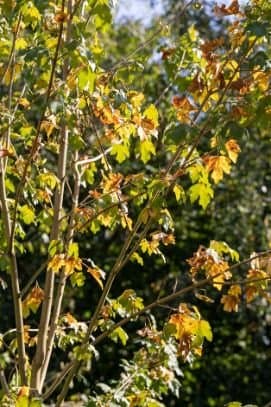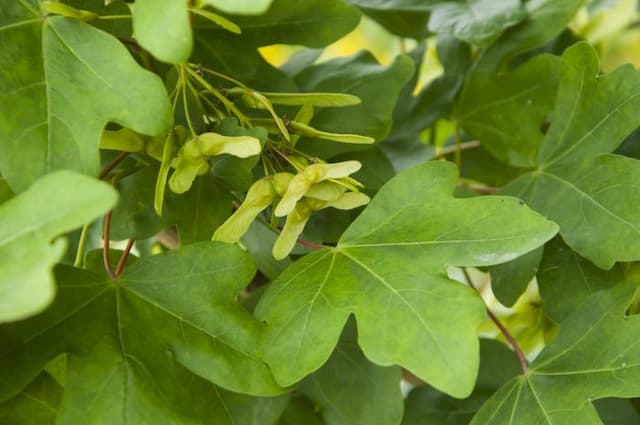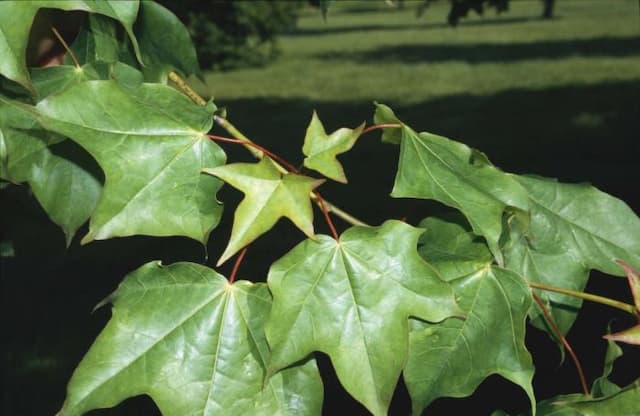Coral Bark Maple Acer palmatum 'Sango-kaku' (P)

ABOUT
The Acer palmatum 'Sango-kaku', commonly known as the Coral Bark Maple, is a visually striking ornamental tree. It is cherished for its distinctive coral-red bark that stands out, especially during winter, adding a splash of color to the landscape when most other plants are dormant. The young branches exhibit the most intense red hue which then fades to a lighter, almost pastel shade as they age. The leaves of the Coral Bark Maple are equally appealing. They are palmate, shaped like a hand with outstretched fingers, featuring five to seven lobes that give them a delicate, feathery appearance. Throughout the seasons, the foliage offers a dynamic display. In spring, the leaves emerge with a light green shade, sometimes tinged with subtle red edges. As the season progresses into summer, the foliage transforms to a deeper green, providing a lush canopy. By fall, the leaves put on a spectacular show, changing to vibrant shades of yellow, gold, and sometimes fiery red, before they eventually fall to reveal the colorful bark beneath. Additionally, small reddish-purple flowers can be found on the Coral Bark Maple in spring, followed by the production of winged seed pods known as samaras that mature in late summer to early fall. These add another layer of ornamental value to the plant. With its changing colors and striking bark, the Coral Bark Maple is a favorite for those seeking year-round interest in their gardens.
About this plant
 Names
NamesFamily
Sapindaceae
Synonyms
Coral Bark Maple, Senkaki Maple, Coral Tower Japanese Maple
Common names
Acer palmatum 'Senkaki'
 Toxicity
ToxicityTo humans
The Japanese Maple is not considered toxic to humans. Generally, there are no adverse effects expected if any part of the plant is ingested. However, as with any plant material, individual sensitivities and allergic reactions can occur. It's always a good practice to avoid ingesting parts of ornamental plants due to the potential for unknown personal allergies or stomach upset.
To pets
The Japanese Maple is generally recognized as non-toxic to pets, including dogs and cats. It is not known to cause any significant symptoms of poisoning if ingested. Nonetheless, it is still advisable to prevent pets from consuming plant material to avoid possible gastrointestinal upset or an unexpected allergic reaction.
 Characteristics
CharacteristicsLife cycle
Perennials
Foliage type
Deciduous
Color of leaves
Varies
Flower color
Red
Height
20-25 feet (6-7.5 meters)
Spread
15-20 feet (4.5-6 meters)
Plant type
Tree
Hardiness zones
5-8
Native area
Japan
Benefits
 General Benefits
General Benefits- Year-round visual interest: The Coral Bark Maple offers a unique appearance throughout the seasons. In spring and summer, its leaves bring a soft green hue, shifting to vibrant golds and reds in the fall. Winter reveals the stunning coral-red bark for which it's named.
- Low maintenance: Acer palmatum 'Sango-kaku' is relatively easy to care for, requiring minimal pruning and being generally resistant to pests and diseases.
- Drought tolerance: Once established, the Coral Bark Maple is drought-tolerant, making it suitable for regions with occasional water restrictions.
- Size appropriateness: With a modest mature size, this maple is well-suited for smaller gardens or spaces where a full-sized tree would be too large.
- Wildlife attraction: The tree can attract birds and beneficial insects to the garden, which helps with pollination and natural pest control.
- Shade provision: The Coral Bark Maple provides a light, dappled shade that is gentle on lawns and understory plantings.
- Soil adaptability: It can adapt to a variety of soil conditions, although it prefers well-draining, slightly acidic soil.
 Medical Properties
Medical PropertiesThis plant is not used for medical purposes.
 Air-purifying Qualities
Air-purifying QualitiesThis plant is not specifically known for air purifying qualities.
 Other Uses
Other Uses- Acer palmatum 'Sango-kaku', commonly known as Coral Bark Maple, branches can be used in floral arrangements, especially during winter when the red bark provides a striking contrast against greenery and flowers.
- The brightly colored bark of the Coral Bark Maple is excellent for garden winter interest, standing out against a backdrop of snow or dull-colored plants.
- The small stature of the Coral Bark Maple makes it well-suited for bonsai cultivation, where its unique features can be enjoyed up close.
- The leaves can be pressed and dried to use in crafts like bookmark making or herbariums, preserving the delicate shapes and colors of the foliage.
- Fallen leaves from the Coral Bark Maple can be used as a natural mulch, providing nutrients to the soil as they decompose and adding a touch of autumnal color to garden beds.
- Acer palmatum 'Sango-kaku' can provide habitat and cover for small birds and wildlife in residential gardens and urban green spaces.
- The shaded area beneath a Coral Bark Maple can be an ideal location for a tranquil outdoor seating area, benefiting from the soft leaf shapes and gentle sway in the wind.
- Artists and photographers often use Coral Bark Maple as a subject in their work due to its distinct, seasonally changing beauty, from lush greens to fiery reds and yellows.
- The Coral Bark Maple's reflections are valued by garden pond enthusiasts, where the tree can create a stunning visual impact on the water's surface with its changing colors.
- Wood from pruned branches of the Coral Bark Maple can be used in small woodworking projects, such as making picture frames or decorative items, where the wood's fine grain can be appreciated.
Interesting Facts
 Feng Shui
Feng ShuiThe Japanese Maple is often used in Feng Shui for its energy of peace and calming. Its fine, lacy leaves and often multi-trunked form can soften the energy of a space, bringing in tranquility and a gentle strength. Its reddish bark symbolizing the fire element can introduce vibrancy and life into a garden or space, which could enhance the energy flow according to Feng Shui principles when placed in the appropriate bagua area.
 Zodiac Sign Compitability
Zodiac Sign CompitabilityThe Japanese Maple is not used in astrology practice.
 Plant Symbolism
Plant Symbolism- Beauty: The Japanese Maple is often associated with beauty due to its delicate leaves and stunning red bark, which stand out in a garden landscape.
- Peace: As a common fixture in Japanese gardens that are designed for contemplation and meditation, it is also linked to peace and tranquility.
- Balance: The tree's balanced and harmonious growth habit reflects the Japanese aesthetic of finding beauty in balance and symmetry, leading it to symbolize equilibrium in life.
- Change: With leaves that change color throughout the seasons, from bright green in spring to rich hues of yellow, red, and orange in the fall, the Japanese Maple represents the changing seasons of life and the beauty of transformation.
 Water
WaterThe Coral Bark Maple requires even moisture and should be watered regularly, especially during dry spells. It's beneficial to establish a weekly watering routine, providing approximately 1-2 gallons of water per week depending on the size of the tree and the weather conditions. During hot summer months, the watering frequency may need to increase to prevent the soil from drying out completely. For mature trees, deep watering is crucial to reach the extended root system; hence, a slow trickle over a longer period is preferred over a quick drench. It is also important to ensure that the soil has good drainage to prevent waterlogging and root rot.
 Light
LightThe Coral Bark Maple thrives best in partial shade to full sun. An ideal location is one where it can enjoy morning sunlight and then receive protection from the harsh afternoon sun, especially in hotter climates. Dappled sunlight throughout the day is also suitable and will help the leaves maintain their vibrant colors without the risk of scorching.
 Temperature
TemperatureCoral Bark Maples are adaptable to a wide range of temperatures but perform best in conditions that mimic their native environment. The ideal temperature range for this tree is between 60°F to 80°F. They are hardy and can withstand minimum temperatures down to around -20°F, making them suitable for USDA hardiness zones 5 through 8. During extreme heat, providing adequate water and some protection from intense sun can prevent stress.
 Pruning
PruningPruning the Coral Bark Maple is typically done to remove dead or damaged branches, to shape the tree, or to improve air circulation within the canopy. The best time for pruning is late winter or early spring before new growth begins. Light pruning can be done any time throughout the year if necessary. Avoid heavy pruning as it can stress the tree and stimulate excessive growth that detracts from the tree's natural form.
 Cleaning
CleaningAs needed
 Soil
SoilThe Coral Bark Maple thrives in well-draining soil that is rich in organic matter with a pH between 5.5 and 6.5. The best soil mix should comprise equal parts of loamy garden soil, peat moss, and perlite or pumice to ensure good aeration and drainage.
 Repotting
RepottingCoral Bark Maples are slow-growing and do not require frequent repotting. Repot every 2-3 years, in the spring before new growth begins. Choose a container only slightly larger than the previous one.
 Humidity & Misting
Humidity & MistingThe Coral Bark Maple prefers average to high humidity levels but is adaptable. It can tolerate the ambient humidity typical of outdoor environments where it's usually grown.
 Suitable locations
Suitable locationsIndoor
Ensure bright, indirect light, and well-draining soil for indoor Coral Bark Maples.
Outdoor
Plant in partial shade, protect from harsh winds, and mulch the soil base.
Hardiness zone
5-8 USDA
 Life cycle
Life cycleAcer palmatum 'Sango-kaku', commonly known as Coral Bark Japanese Maple, begins its life cycle when seeds, after a period of stratification, germinate in early spring. It enters a sapling phase, marked by the growth of distinctive coral-red branches and a period of establishing its root system. As it matures into a juvenile tree, it begins to develop its characteristic palmate leaves which change from bright green to golden yellow and fiery red in the fall. Upon reaching maturity, the tree experiences annual cycles of flowering in the spring, followed by seed production, which disperses for new generation growth. Throughout its lifespan, which can extend beyond 60 years if conditions are favorable, Acer palmatum 'Sango-kaku' undergoes seasonal leaf-drop in late fall, entering a period of winter dormancy. Its growth and vigor will eventually decline as it enters its senescence stage, concluding the life cycle of this ornamental plant.
 Propogation
PropogationPropogation time
Early spring
The Japanese Maple 'Sango-kaku' is often propagated through softwood cuttings, which is the most popular method due to its effectiveness. This technique is best performed in late spring or early summer when the tree's new growth is mature enough but still pliable. To propagate, a gardener should take a cutting of about 6 to 8 inches (15 to 20 centimeters) from a healthy branch, ensuring there are at least two sets of leaves present. The lower leaves are removed, and the cut end of the stem is often dipped in a rooting hormone to encourage root development. The cutting is then placed in a pot filled with a mix of peat and perlite or a similar well-draining rooting medium. It should be kept under high humidity and indirect light until roots have developed, which typically takes several weeks. After rooting, the plant can be gradually acclimated to less humid conditions and eventually planted in its permanent location.







![Freeman maple [Autumn Blaze]](/_next/image?url=https%3A%2F%2Fplants-admin.emdemapps.com%2Fimages%2Fplants%2F%2Fimages%2F604b575b84d87.png&w=640&q=75)

